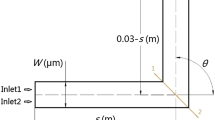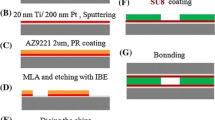Abstract
The effect of various patterned micro-grooved floors on the mixing efficiency in an AC electro-thermal (ACET) actuated micromixer is studied thoroughly. The patterns such as VU, VIU, VUVIU and VIUVU with different heights are considered for the analysis. Asymmetric electrode pairs are attached to the grooved surface to generate the ACET induced flow. At the same time, the symmetric electrode pairs are inserted on the top wall to enhance the mixing process. The potential at asymmetric and symmetric electrode pairs has been tuned in the range of 3–8 V and 0–10 V to modulate the flow for achieving better mixing efficiency and a higher flow rate. It is found that a mixing efficiency of 0.98 has been achieved for all types of microgrooves when the AC electric potential at the lower electrode pairs is less than 4 V and at the upper electrode pairs is more than 8 V. When the potential at the lower electrode pairs is increased to 8 V, mixing efficiency is found to be reduced and a maximum value is observed to be 0.60 in case of the VIUVU groove. The pumping in the VU groove is better, resulting in a higher flow rate, almost two times more than the others. Mixing efficiency is marginally more for the VU groove with a shorter height; however, it contradicts with other grooves.










Similar content being viewed by others
References
Abbassi H (2007) Entropy generation analysis in a uniformly heated microchannel heat sink. Energy 32:1932–1947
Bandopadhyay A, Mandal S, Chakraborty A (2016) Streaming potentialmodulated capillary filling dynamics of immiscible fluids. Soft Matter 12:2056
Cao J, Cheng P, Hong FJ (2008) A numerical study of an electrothermal vortex enhanced micromixer. Microfluid Nanofluid 5(1):13–21
Castellanos A, Ramos A, Gonzalez A, Green NG, Morgan H (2003) Electrohydrodynamics and dielectrophoresis in microsystems: scaling laws. J Phys D 36:2584
Chakraborty S (2007) Electroosmotically driven capillary transport of typical non-Newtonian biofluids in rectangular microchannels. Anal Chim Act A 605:175
COMSOL, Inc (2015) COMSOL multiphysics. COMSOL, Inc, Stockholm
Cui J, Fu Y (2012) A numerical study on pressure drop in microchannel flow with different bionic micro-grooved surfaces. J Bionic Eng 9(1):99–109
Du E, Manoochehri S (2008) Enhanced ac electrothermal fluidic pumping in microgrooved channels. J Appl Phys 104(6):064902
Gonzalez A, Ramos A, Green N, Castellanos A, Morgan H (2000) Fluid flow induced by nonuniform ac electric fields in electrolytes on microelectrodes. Phys Rev E 61:4019–4028
Green NG, Ramos A, Morgan H (2000) Ac electrokinetics: a survey of sub-micrometre particle. J Phys D 33:632
Kunti G, Bhattacharya A, Chakraborty S (2017a) A scaling analysis for electrohydrodynamic convection with variable thermophysical and electrical properties. Int J Heat Mass Transf 109:215
Kunti G, Bhattacharya A, Chakraborty S (2017b) Rapid mixing with highthroughput in a semi-active semi-passive micromixer”. Electrophoresis 38:1310
Lian M, Islam N, Wu J (2007) AC electrothermal manipulation of conductive fluids and particles for lab-chip applications. IET Nanobiotechnol 1:36
Liu RH, Stremler MA, Sharp KV, Olsen MG, Santiago JG, Adrian RJ, Hassan A, Beebe DJ (2000) Passive mixing in a three dimensional serpentine microchannel. J Microelectromech Syst 9:190–197
Liu X, Yang K, Wadhwa A, Eda S, Li S, Wu J (2011) Development of an AC electrokinetics-based immunoassay system for on-site serodiagnosis of infectious diseases. Sens Actuator A Phys 171:406–413
Liu W, Ren Y, Shao J, Jiang H, Ding Y (2014) A theoretical and numerical investigation of travelling wave induction microfluidic pumping in a temperature gradient. J Phys D Appl Phys 47:075501
Ma C, Bothe D (2011) Direct numerical simulation of thermocapillary flow based on the volume of fluid method. Int J Multiphase Flow 37:1045
Mondal SB, Pati S, Patowari PK (2019) Analysis of mixing performances in microchannel with obstacles of different aspect ratios. Proc Inst Mech Eng Part E J Process Mech Eng 233(5):1045–1051
Morgan H, Green NG (2003) AC electrokinetics: colloids and nanoparticles research. Studies Press, Philadelphia
Ng WY, Goh S, Lam YC, Yang C, Rodrıguez I (2009) An AC electrothermal self-circulating system with a minimalist process to construct a biomimetic liver lobule model for drug testing. Lab Chip 9:802–809
Pal D, Chakraborty S (2015) Fluid flow induced by periodic temperature oscillation over a flat plate: Comparisons with the classical Stokes problems. Phys Fluids 27:053601
Ramos A (2011) Electrokinetics and electrohydrodynamics in microsystems CISM courses and lectures. Springer, New York
Ramos A, Morgan H, Green NG, Castellanos A (1998) Ac electrokinetics: a review of forces in microelectrode structures. J Phys D 31:2338
Ramos A, Morgan H, Green NG, Castellanos A (1999) AC electrokinetics: a review of forces in microelectrode structures. J Phys D Appl Phys 31:2338
Ramos A, Morgan H, Green NG, Castellanos A (1999) The role of electrohydrodynamic forces in the dielectrophoretic manipulation and separation of particles. J Phys D Appl Phys 31:2338–2353
Ray B, Reddy PDS, Bandyopadhyay D, Joo SW, Sharma A, Qian S, Biswas G (2011) Surface instability of a thin electrolyte film undergoing coupled electroosmotic and electrophoretic flows in a microfluidic channel. Electrophoresis 32:3257
Reyes DR, Lossifidis D, Auroux PA, Manz A (2002) Micro total analysis systems. 1. Introduction, theory, and technology. Anal Chem 74:2623–2636
Salari A, Navi M, Dalton C (2015) A novel alternating current multiple array electrothermal micropump for lab-on-a-chip applications. Biomicrofluidics 9:014113
Sharma CS, Tiwari MK, Zimmermann S, Brunschwiler T, Schlottig G, Michel B et al (2015) Energy efficient hotspot-targeted embedded liquid cooling of electronics. Appl Energy 138:414–422
Stubbe M, Gimsa J (2011) A short review on AC electro-thermal micropumps based on smeared structural polarizations in the presence of a temperature gradient. Colloids Surf A 376:97–101
Vafaie RH, Ghavifekr HB, Van Lintel H, Brugger J, Renaud P (2016) Bi-directional ACET micropump for on-chip biological applications. Electrophoresis 37(5–6):719–726
Wang HZ, Lovenitti P, Harvey E (2003) Masood S Numerical investigation of mixing in microchannels with patterned grooves. J Micromech Microeng 13:801–808
Wang GR, Yang F, Zhao W (2014) There can be turbulence in microfluidics at low Reynolds number. Lab Chip 14(8):1452–1458
Wu J, Lian M, Yang K (2007) Micropumping of biofluids by alternating current electrothermal eects Appl. Phys Lett 90:234103
Zhang R, Dalton C, Jullien GA (2011) Two-phase AC electrothermal fluidic pumping in a coplanar asymmetric electrode array. Microfluid Nanofluid 10:521–529
Zhang F, Chen H, Chen B, Wu J (2016) Adv Mech Eng 8:1–10
Funding
The authors declare no funding for the present work.
Author information
Authors and Affiliations
Corresponding author
Ethics declarations
Conflict of interest
The authors have no conflict of interest with any third party.
Additional information
Publisher's Note
Springer Nature remains neutral with regard to jurisdictional claims in published maps and institutional affiliations.
Rights and permissions
Springer Nature or its licensor (e.g. a society or other partner) holds exclusive rights to this article under a publishing agreement with the author(s) or other rightsholder(s); author self-archiving of the accepted manuscript version of this article is solely governed by the terms of such publishing agreement and applicable law.
About this article
Cite this article
Acharya, S., Bhargawa, A. Electro-thermal actuated micromixer with VU/VIU/VUVIU/VIUVU patterned microgrooves. Braz. J. Chem. Eng. 40, 1005–1025 (2023). https://doi.org/10.1007/s43153-022-00293-9
Received:
Revised:
Accepted:
Published:
Issue Date:
DOI: https://doi.org/10.1007/s43153-022-00293-9




